About Publications Library Archives
heritagepost.org

Preserving Revolutionary & Civil War History

Preserving Revolutionary & Civil War History
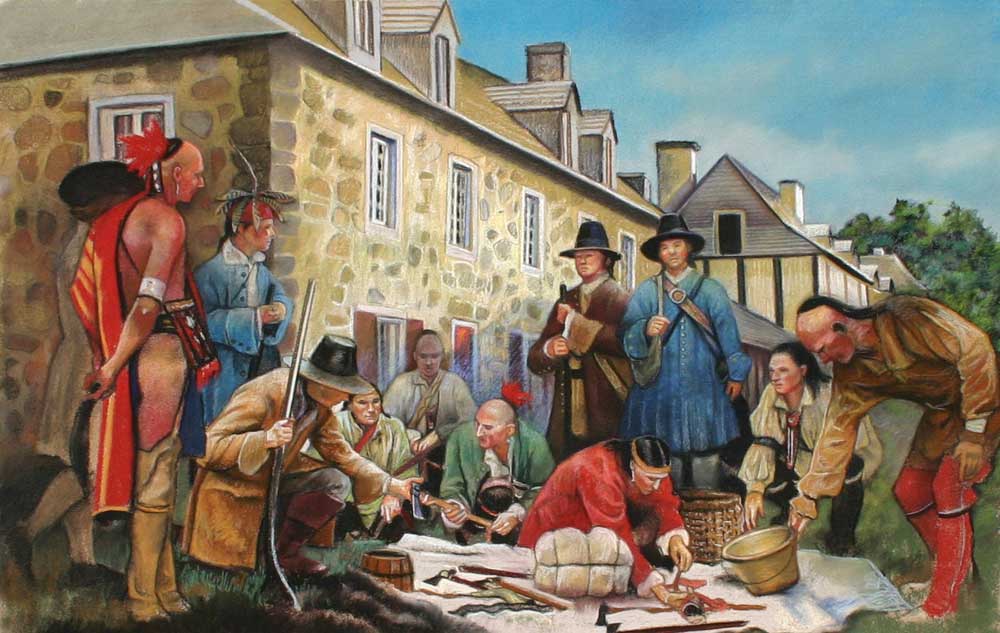
The Beaver Wars, also known as the Iroquois Wars or the French and Iroquois Wars (French: Guerres franco-iroquoises), encompass a series of conflicts fought intermittently during the 17th century in America. They were battles for economic welfare throughout the Saint Lawrence River valley in Canada and the lower Great Lakes region which pitted the Iroquois against the northern Algonquians and the Algonquians’ French allies. From medieval times, Europeans had obtained furs from Russia and Scandinavia. American pelts came on the market during the 16th century, decades before the French, English, and Dutch established permanent settlements and trading posts on the continent. Basque fishermen chasing cod off Newfoundland’s Grand Banks bartered with local Indigenous peoples for beaver robes to help fend off the Atlantic chill. By virtue of their location, the tribes wielded considerable influence in European–Indian relations from the early seventeenth century onwards.
The Iroquois sought to expand their territory into the Ohio Country and to monopolize the fur trade with European markets. They originally were a confederacy of the Mohawk, Oneida, Onondaga, Cayuga, and Seneca tribes inhabiting the lands in Upstate New York along the shores of Lake Ontario east to Lake Champlain and Lake George on the Hudson river, and the lower-estuary of the Saint Lawrence River. The Iroquois Confederation led by the Mohawks mobilized against the largely Algonquian-speaking tribes and Iroquoian-speaking Huron and related tribes of the Great Lakes region. The Iroquois were armed by their Dutch and English trading partners; the Algonquians and Hurons were backed by the French, their chief trading partner.
The Iroquois effectively destroyed several large tribal confederacies, including the Mahicans (Mohicans), Huron (Wyandot), Neutral, Erie, Susquehannock (Conestoga), and northern Algonquins. They became dominant in the region and enlarged their territory, realigning the American tribal geography. The Iroquois gained control of the New England frontier and Ohio River valley lands as hunting ground from about 1670 onward.
Both Algonquian and Iroquoian societies were greatly disrupted by these wars. The conflict subsided when the Iroquois lost their Dutch allies in the New Netherland colony after England took it over in 1664, with Fort Amsterdam and the town of New Amsterdam on Manhattan Island. The French had the objective of gaining the Iroquois as an ally against English encroachment, but they became trading partners with the English. Their alliance was a crucial component of the English western and northern expansion leading to the French and Indian War (1754–1763).
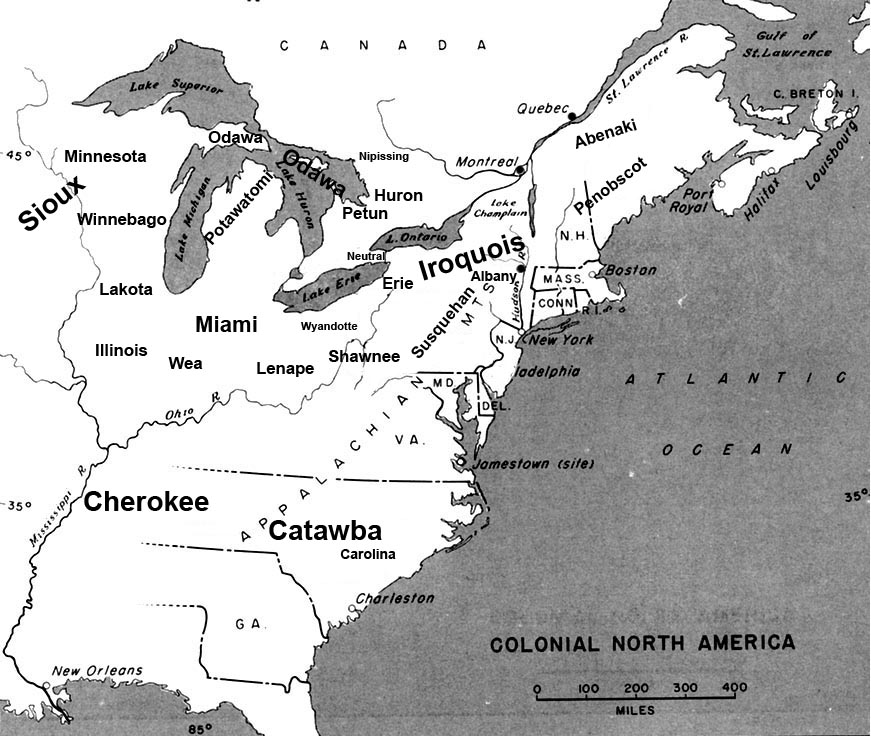
Wars and politics in Europe distracted French efforts at colonization in the St. Lawrence Valley until the beginning of the 17th century, when they founded Quebec in 1608. When the French returned to the area, they found both sites abandoned by the Stadacona and Hochelaga and completely destroyed,[6] and they found no inhabitants in this part of the upper river valley—although the Iroquois and the Huron[6] used it as hunting ground.[5][7] The causes remain unclear, although some anthropologists and historians have suggested that the Mohawk Nation of the Iroquois Confederacy destroyed or drove out the St. Lawrence Iroquoians.[6]
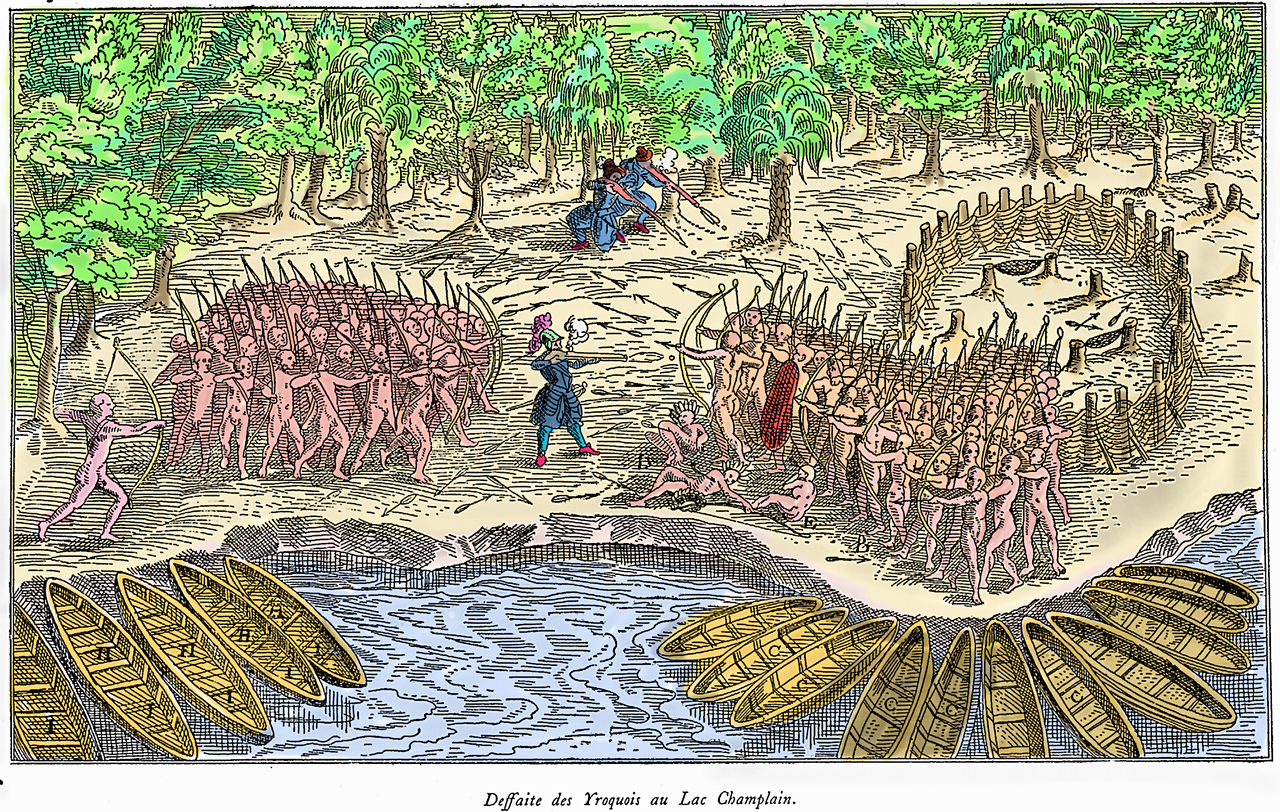
Before 1603, Champlain had formed an alliance against the Iroquois, as he decided that the French would not trade firearms to them.[6] The northern Indians provided the French with valuable furs, and the Iroquois interfered with that trade. The first battle with the Iroquois in 1609 was fought at Champlain’s initiative.[6] Champlain wrote, “I had come with no other intention than to make war”.[8] He and his Huron and Algonkin allies fought a pitched battle against the Mohawks on the shores of Lake Champlain.[6] Champlain single-handedly[6] killed three chiefs with an arquebus despite the war chiefs’ “arrowproof body armor made of plaited sticks”.[6]
In 1610, Champlain and his French companions helped the Algonquins and the Hurons defeat a large Iroquois raiding party. In 1615, he joined a Huron raiding party and took part in a siege on an Iroquois town, probably among the Onondaga south of Lake Ontario in New York. The attack ultimately failed, and Champlain was injured.[9]
In 1610-1614, the Dutch established a series of seasonal trading posts on the Hudson and Delaware rivers, including one on Castle Island at the eastern edge of Mohawk territory near Albany.[6] This gave the Iroquois direct access to European markets via the Mohawks. The Dutch trading efforts and eventual colonies in New Jersey and Delaware soon also established trade with the coastal Delaware tribe (Lenape) and the more southerly Susquehannock tribe. The Dutch founded Fort Nassau in 1614 and its 1624 replacement Fort Orange (both at Albany) which removed the Iroquois’ need to rely on the French and their allied tribes or to travel through southern tribal territories to reach European traders. The Dutch supplied the Mohawks and other Iroquois with guns.[6] In addition, the new post offered valuable tools that the Iroquois could receive in exchange for animal pelts.[6] They began large-scale hunting for furs to satisfy demand among their peoples for new products.[6][10]
At this time, conflict began to grow between the Iroquois Confederacy and the tribes supported by the French. The Iroquois inhabited the region of New York south of Lake Ontario and west of the Hudson River. Their lands were surrounded on all sides but the south by Algonquian-speaking tribes, all traditional enemies, including the Shawnee to the west in the Ohio Country, the Neutral Nation and Huron confederacies on the western shore of Lake Ontario and southern shore of Lake Huron to the west, and the Susquehannock to their south. These tribes were historically competitive with and sometimes enemies of the Iroquois, who had Five Nations in their confederacy.
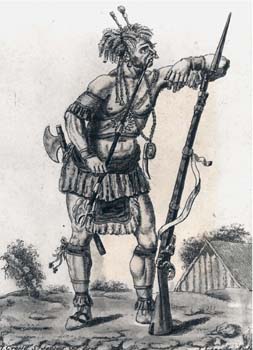
In 1628, the Mohawks defeated the Mahicans, pushing them east of the Hudson River and establishing a monopoly of trade with the Dutch at Fort Orange, New Netherland. The Susquehannocks were also well armed by Dutch traders, and they effectively reduced the strength of the Delawares and won a protracted war with the English-dominated Province of Maryland.[6] By the 1630s, the Iroquois had become fully armed with European weaponry through their trade with the Dutch.
The Iroquois relied on the trade for firearms and other highly valued European goods for their livelihood and survival. They used their growing expertise with the arquebus to good effect in their continuing wars with the Algonquins and Hurons, and other traditional enemies. The French, meanwhile, outlawed the trading of firearms to their Indian allies, though they occasionally gave arquebuses as gifts to individuals who converted to Christianity. The Iroquois attacked their traditional enemies the Algonquins, Mahicans, Montagnais, and Hurons, and the alliance of these tribes with the French quickly brought the Iroquois into conflict directly with the colonists.
The expansion of the fur trade with Europe brought a decline in the beaver population in the region, and the animal had largely disappeared from the Hudson Valley by 1640. American Heritage Magazine notes that the growing scarcity of the beaver in the lands controlled by the Iroquois in the middle 17th century accelerated the wars.[6] The center of the fur trade shifted north to the colder regions of southern Ontario, an area controlled by the Neutral and Huron tribes who were close trading partners with the French.
With the decline of the beaver population, the Iroquois began to conquer their smaller neighbors. They attacked the Wenro in 1638 and took all of their territory, and survivors fled to the Hurons for refuge. The Wenro had served as a buffer between the Iroquois and the Neutral tribe and their Erie allies. The Neutral and Erie tribes were considerably larger and more powerful than the Iroquois, so the Iroquois turned their attention to the north[11] and the Dutch encouraged them in this strategy. At that time, the Dutch were the Iroquois’ primary European trading partners, with their goods passing through Dutch trading posts down the Hudson River. As the Iroquois’ sources of furs declined, however, so did the income of the trading posts.[12]

In 1641, the Mohawks traveled to Trois-Rivières in New France to propose peace with the French and their allied tribes, and they asked the French to set up a trading post in Iroquoia. Governor Montmagny rejected this proposal because it would imply abandonment of their Huron allies.
In the early 1640s, the war began in earnest with Iroquois attacks on frontier Huron villages along the St. Lawrence River in order to disrupt the trade with the French. In 1645, the French called the tribes together to negotiate a treaty to end the conflict, and Iroquois leaders Deganaweida and Koiseaton traveled to New France to take part in the negotiations.[13] The French agreed to most of the Iroquois demands, granting them trading rights in New France. The next summer, a fleet of 80 canoes traveled through Iroquois territory carrying a large harvest of furs to be sold in New France. When they arrived, however, the French refused to purchase the furs and told the Iroquois to sell them to the Hurons, who would act as a middleman. The Iroquois were outraged and resumed the war.[13]
The French decided to become directly involved in the conflict. The Huron and the Iroquois had an estimated 25,000 to 30,000 members each.[14] The Hurons and Susquehannocks formed an alliance to counter Iroquois aggression in 1647, and their warriors greatly outnumbered those of the Iroquois. The Hurons tried to break the Iroquois Confederacy by negotiating a separate peace with the Onondaga and Cayuga tribes, but the other tribes intercepted their messengers and put an end to the negotiations. During the summer of 1647, there were several small skirmishes between the tribes, but a more significant battle occurred in 1648 when the two Algonquin tribes passed a fur convoy through an Iroquois blockade. They succeeded and inflicted high casualties on the Iroquois.[15] In the early 1650s, the Iroquois began attacking the French themselves, although some of the Iroquois tribes had peaceful relations with them, notably the Oneida and Onondaga tribes. They were under control of the Mohawks, however, who were the strongest tribe in the Confederation and had animosity towards the French presence. After a failed peace treaty negotiated by Chief Canaqueese, Iroquois moved north into New France along Lake Champlain and the Richelieu River, attacking and blockading Montreal. By 1650, they controlled the area from the Virginia Colony in the south up to the St. Lawrence. In the west, the Iroquois had driven the Algonquin-speaking Shawnee out of the Ohio Country and seized control of the Illinois Country as far west as the Mississippi River. In January 1666, the French invaded the Iroquois and took Chief Canaqueese prisoner. In September, they proceeded down the Richelieu but were unable to find an Iroquois army, so they burned their crops and homes. Many Iroquois died from starvation in the following winter. During the following years, the Iroquois strengthened their confederacy to work more closely and create an effective central leadership, and the five tribes ceased fighting among themselves by the 1660s. They also easily coordinated military and economic plans, and they increased their power as a result.[16]

Indian raids were not constant, but they terrified the inhabitants of New France, and some of the heroes of French-Canadian folklore are individuals who stood up to such attacks. Dollard des Ormeaux, for example, died in May 1660 while resisting an Iroquois raiding force at the Battle of Long Sault, the confluence of the St. Lawrence and the Ottawa Rivers, but saved Montreal by his actions. In 1692, 14 year-old Marie-Madeleine Jarret successfully frustrated an Iroquois attack on Fort Verchères.
In 1648, the Dutch authorized selling guns directly to the Mohawks rather than through traders, and promptly sold 400 to the Iroquois. The Confederacy sent 1,000 newly armed warriors through the woods to Huron territory with the onset of winter, and they launched a devastating attack into the heart of Huron territory, destroying several key villages, killing many warriors, and taking thousands of people captive for later adoption into the tribe. Among those killed were Jesuit missionaries Jean Brebeuf, Charles Garnier, and Gabriel Lallemant, each of whom is considered a martyr of the Roman Catholic Church. The surviving Hurons fled their territory to seek assistance from the Anishinaabeg Confederacy in the northern Great Lakes region. The Ottawa tribe temporarily halted Iroquois expansion further northwest, but the Iroquois controlled a fur-rich region and had no more tribes blocking them from the French settlements in Canada.[17]
Diseases had taken their toll on the Iroquois and neighbors in the years preceding the war, however, and their populations had drastically declined. To replace lost warriors, they worked to integrate many of their captured enemies by adoption into their own tribes. They invited Jesuits into their territory to teach those who had converted to Christianity. The Jesuits also reached out to the Iroquois, many of whom converted to Roman Catholicism or intermingled its teachings with their own traditional beliefs.[18]
The Iroquois attacked the Neutrals in 1650, and they completely drove the tribe from traditional territory by the end of 1651, killing or assimilating thousands.[17] The Neutrals had inhabited a territory ranging from the Niagara Peninsula westward to the Grand River valley.[19]
In 1654, the Iroquois attacked the Erie tribe, but with less success. The war lasted for two years, and the Iroquois destroyed the Erie confederacy by 1656, whose members refused to flee to the west. The Erie territory was located on the southeastern shore of Lake Erie and was estimated to have 12,000 members in 1650.[20] The Iroquois were greatly outnumbered by the tribes that they subdued, but they achieved their victories through the use of firearms purchased from the Dutch.[17]
The Iroquois continued to control the countryside of New France, raiding to the edges of the walled settlements of Quebec and Montreal. In May 1660, an Iroquois force of 160 warriors attacked Montreal and captured 17 colonists. The following year, 250 warriors attacked and took ten captives.[21] In 1661 and 1662, the Iroquois made several raids against the Abenakis who were allied with the French. The French Crown ordered a change to the governing of Canada. They put together a small military force made up of Frenchmen, Hurons, and Algonquins to counter the Iroquois raids, but the Iroquois attacked them when they ventured into the countryside. Only 29 of the French survived and escaped; five were captured and tortured to death by the Iroquois. Despite their victory, the Iroquois also suffered a significant number of casualties, and their leaders began to consider negotiating for peace with the French.[22]
The tide of war began to turn in the mid-1660s with the arrival of the Carignan-Salières Regiment, a small contingent of regular troops from France and the first group of uniformed professional soldiers in Canada. A change in administration led the New France government to authorize direct sale of arms and other military support to their Indian allies. In 1664, the Dutch allies of the Iroquois lost control of the New Netherland colony to the English. In the immediate years after the Dutch defeat, European support waned for the Iroquois.[21]

In January 1666, the French invaded the Iroquois homeland in New York. The first invasion force of 400 to 500 men[23] was led by Daniel de Rémy de Courcelle. His men were greatly outnumbered by the Iroquois and were forced to withdraw before any significant action could take place, but they took Chief Canaqueese prisoner.
The second invasion force was led by Alexandre de Prouville, the “Marquis de Tracy” and viceroy of New France, from his base in Quebec City. The invasion force of about 1,300 men moved out in the fall of 1666. They found the Mohawk villages deserted, so they destroyed the villages and their crops.[23] Prouville de Tracy seized all the Mohawk lands in the name of the king of France and forced the Mohawks to accept the Roman Catholic faith and to adopt the French language, as taught by Jesuit missionaries.[24] The Iroquois sued for peace and France agreed.
Once peace was achieved with the French, the Iroquois returned to their westward conquest in their continued attempt to take control of all the land between the Algonquins and the French. Eastern tribes such as the Lakotas were pushed across the Mississippi onto the Great Plains in the early 18th century, where they adopted the horse culture and nomadic lifestyle for which they later became known. Other refugees flooded the Great Lakes area, resulting in a conflict with existing tribes in the region. In the Ohio Country, the Shawnee and Miami tribes were dominant. The Iroquois quickly overran Shawnee holdings in central Ohio, forcing them to flee into Miami territory. The Miamis were a powerful tribe and brought together a confederacy of their neighboring allies, including the Pottawatomie and the Illini confederation who inhabited Michigan and Illinois. The majority of the fighting was between the Anishinaabeg Confederacy and the Iroquois Confederacy.[25]
The Iroquois improved on their warfare as they continued to attack even farther from their home. War parties often traveled by canoes at night, and they would sink their canoes and fill them with rocks to hold them on the river bottom. They would then move through the woods to a target and burst from the wood to cause the greatest panic. After the attack, they returned to their boats and left before any significant resistance could be put together.[26] The lack of firearms caused the Algonquin tribes the greatest disadvantage. Despite their larger numbers, they were not centralized enough to mount a united defense and were unable to withstand the Iroquois. Several tribes ultimately moved west beyond the Mississippi River, leaving much of the Ohio Valley, southern Michigan, and southern Ontario depopulated. Several Anishinaabe forces numbering in the thousands remained to the north of Lakes Huron and Superior, and they were later decisive in rolling back the Iroquois advance.[27] From west of the Mississippi, displaced groups continued to arm war parties and attempt to retake their land.
Beginning in the 1670s, the French began to explore and settle the Ohio and Illinois Country from the Mississippi and Ohio rivers, and they established the post of Tassinong to trade with the western tribes. The Iroquois destroyed it to retain control of the fur trade with the Europeans. The Iroquois also drove the Mannahoac tribe out of the northern Virginia Piedmont region in 1670, and they claimed the land by right of conquest as a hunting ground. The English acknowledged this claim in 1674 and again in 1684, but they acquired the land from the Iroquois by a 1722 treaty.
During a raid into the Illinois Country in 1689, the Iroquois captured numerous prisoners and destroyed a sizable Miami settlement. The Miami asked for aid from others in the Anishinaabeg Confederacy, and a large force gathered to track down the Iroquois. Using their new firearms, the Confederacy laid an ambush near South Bend, Indiana, and they attacked and destroyed most of the Iroquois party,[28] and a large part of the region was left depopulated. The Iroquois were unable to establish a permanent presence, as their tribe was unable to colonize the large area,[29] and the Iroquois’ brief control over the region was lost. Many of the former inhabitants of the territory began to return.[30]
With the tribes destroyed to the north and west, the Iroquois turned their attention southward to the Susquehannocks. They attained the peak of their influence in 1660, and they were able to use that to their advantage in the following decades.[31] The Susquehannocks had become allied with the Maryland Colony in 1661, as the colonists had grown fearful of the Iroquois and hoped that an alliance would help block the northern tribes’ advance on the colonies. In 1663, the Iroquois sent 800 warriors into the Susquehannock territory. The Susquehannocks repulsed them, but the unprovoked attack prompted the colony of Maryland to declare war on the Iroquois.
By supplying Susquehannock forts with artillery, the Maryland colonists turned the tables on the Iroquois. The Susquehannocks took the upper hand and began to invade Iroquois territory, where they caused significant damage. This warfare continued intermittently for 11 years. In 1674, the Maryland colonists changed their Indian policy, negotiated peace with the Iroquois, and terminated their alliance with the Susquehannocks. In 1675, the militias of Virginia and Maryland captured and executed the Susquehannock chiefs, whose growing power they feared. The Iroquois drove the warriors from traditional territory[32] and absorbed the survivors in 1677.
English colonization began to move into the former Dutch territory of upper New York State, and the colonists began to form close ties with the Iroquois as an alliance in the face of French colonial expansion. They began to supply the Iroquois with firearms as the Dutch had. At the same time, New France’s governor Louis de Buade tried to revive the western fur trade. His efforts competed with those of the Iroquois to control the traffic and they started attacking the French again. The war lasted ten years.
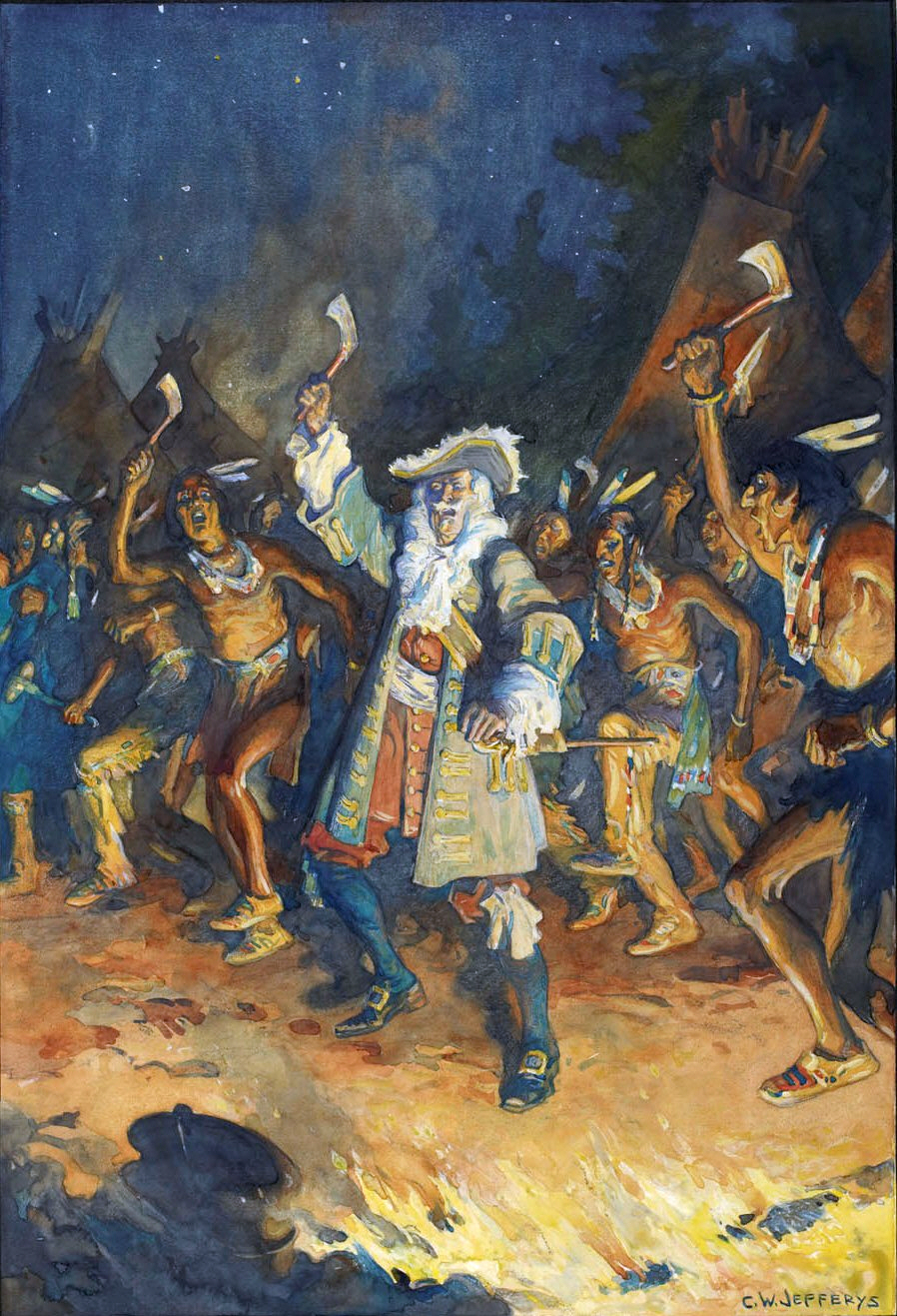
In 1681, René-Robert Cavelier, Sieur de La Salle negotiated a treaty with the Miami and Illinois tribes.[33] France lifted the ban on the sale of firearms to the Indians, and colonists quickly armed the Algonquin tribes, evening the odds between the Iroquois and their enemies.
With the renewal of hostilities, the militia of New France was strengthened after 1683 by a small force of regular French navy troops in the Compagnies Franches de la Marine, who constituted the longest serving unit of French regular troops in New France. In June 1687, Governor Denonville and Pierre de Troyes set out with a well organized force to Fort Frontenac, where they met with the 50 sachems of the Iroquois Confederacy from their Onondaga council.[34] These 50 chiefs constituted the top leaders of the Iroquois, and Denonville captured them and shipped them to Marseilles, France to be galley slaves. He then travelled down the shore of Lake Ontario and built Fort Denonville at the site where the Niagara River meets Lake Ontario. This site was previously used by La Salle for Fort Conti from 1678 to 1679, and was later used for Fort Niagara which still exists. The Iroquois retaliated by destroying farmsteads and slaughtering entire families. They burned Lachine to the ground on August 4, 1689. Frontenac replaced Denonville as governor for the next nine years (1689–1698), and he recognized the danger created by the imprisonment of the sachems. He located the 13 surviving leaders and returned with them to New France in October 1698.
During King William’s War (1688–1697), the French formed raiding parties with Indian allies to attack English colonial settlements, as the English had allied themselves with the Iroquois against the French, carrying out the Schenectady massacre in the Province of New York, the Raid on Salmon Falls, New Hampshire, and the Battle of Fort Loyal in Portland, Maine. The French and their allies killed settlers in the raids and carried some back to Canada. Settlers in New England raised money to redeem the captives, but some were adopted into the tribes. The French government generally did not intervene when the Indians kept the captives. Throughout the 1690s, the French and their allies also continued to raid deep into Iroquois territory, destroying Mohawk villages in 1692 and raiding Seneca, Oneida, and Onondaga villages. The English colonists and Iroquois banded together for operations aimed at New France, but these were largely ineffective. The most successful incursion resulted in the 1691 Battle of La Prairie. The French offensive was not halted by the 1697 Treaty of Ryswick that brought peace between France and England, but it ended English participation in the conflict.
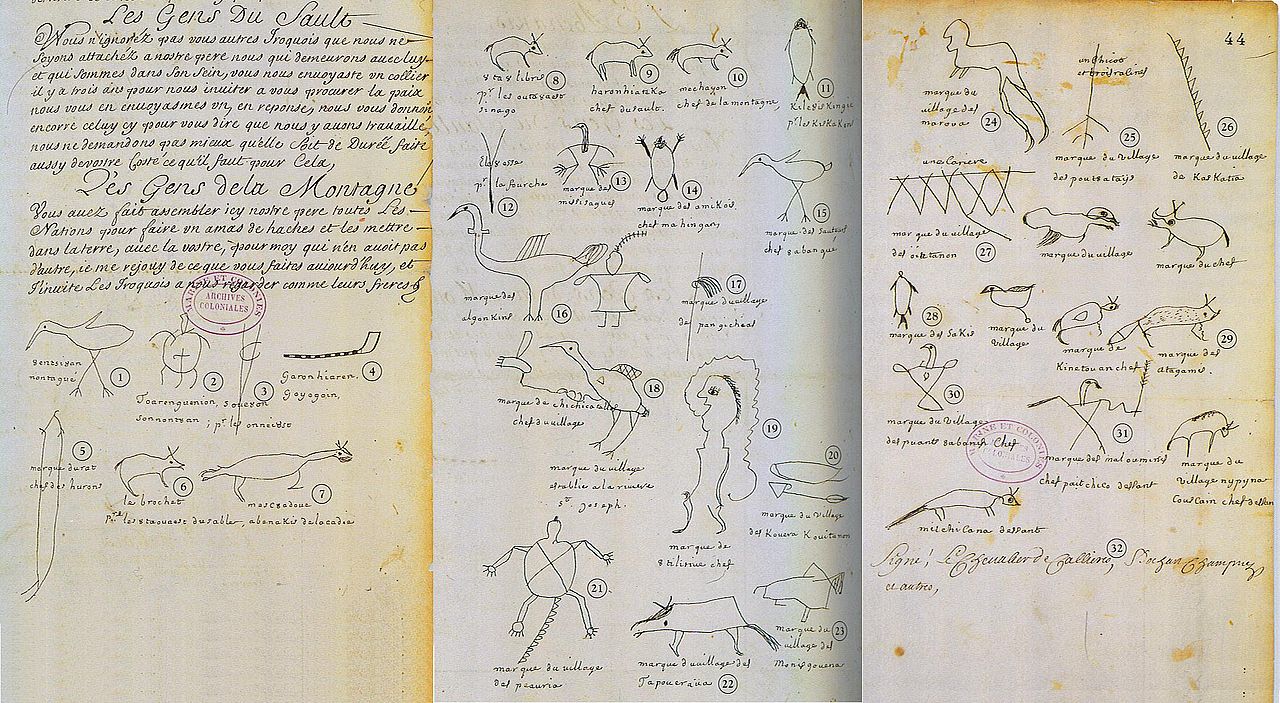
The Iroquois began to see the English as a greater threat than the French in 1698. The English had begun colonizing Pennsylvania in 1681, and the continued colonial growth there began to encroach on the southern border of the Iroquois territory.[12] The French policy began to change towards the Iroquois after nearly 50 years of warfare, and they decided that befriending them would be the easiest way to ensure their monopoly on the northern fur trade and stop English colonization. The English colonies heard of the treaty and immediately set about to prevent it from being agreed to. It would result in the loss of Albany’s fur trade with the Iroquois and, without their protection, the northern flank of the English colonies would be open to French attack. Nevertheless, the French and Indians signed the treaty.[35]
The French and 39 Indian chiefs signed the Great Peace of Montreal in 1701. The Iroquois agreed to stop marauding and to allow refugees from the Great Lakes to return east. The Shawnee eventually regained control of the Ohio Country and the lower Allegheny River. The Miami tribe returned to take control of Indiana and northwest Ohio. The Pottawatomie went to Michigan, and the Illinois tribe to Illinois.[35] The peace lasted into the 1720s.[36]
In 1768, several colonies purchased the “Iroquois claim” to the Ohio and Illinois Country and created the Indiana Land Company to hold the claim to all of the Northwest. It maintained a claim to the region using the Iroquois right of conquest until the company was dissolved in 1798 by the United States Supreme Court.[37]